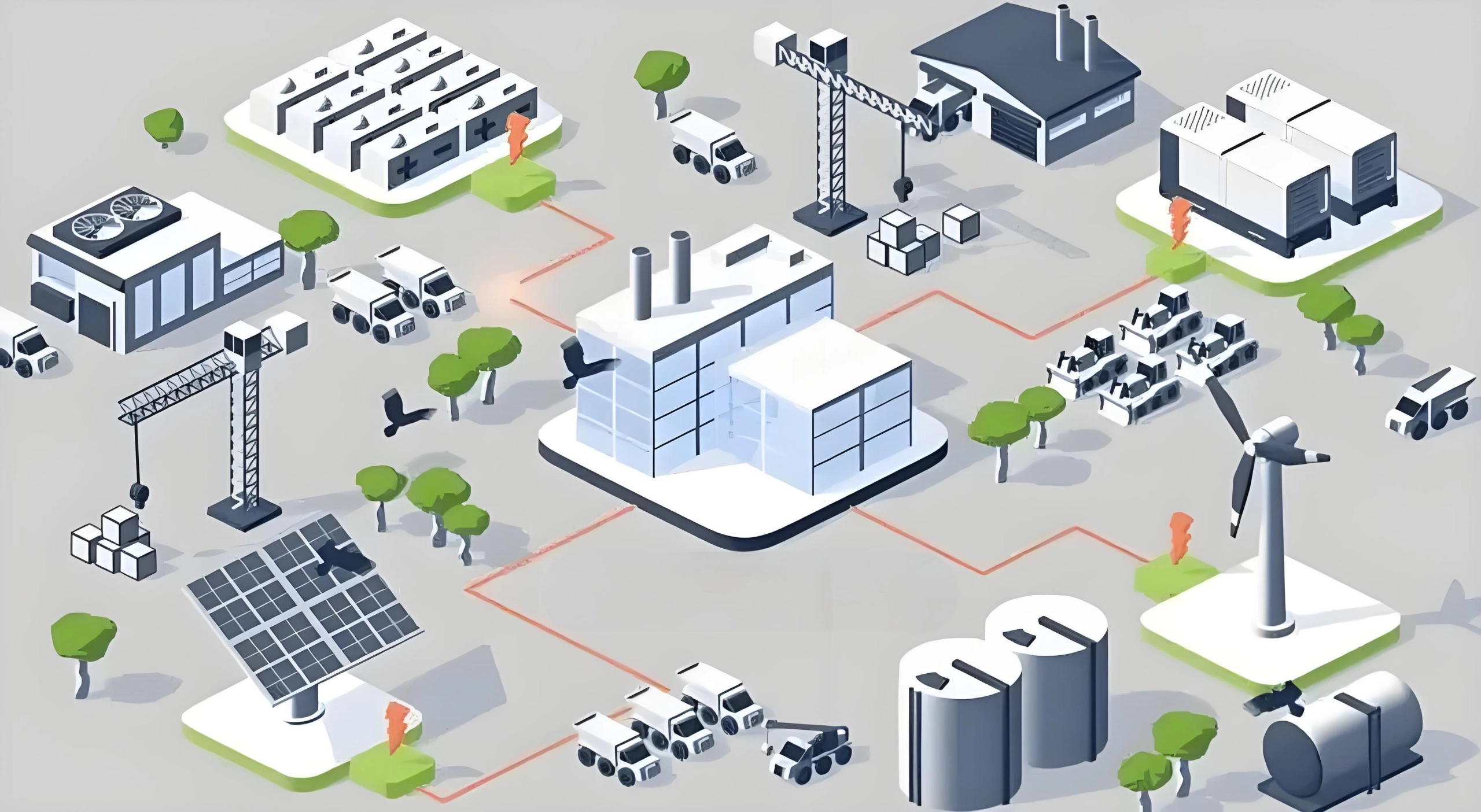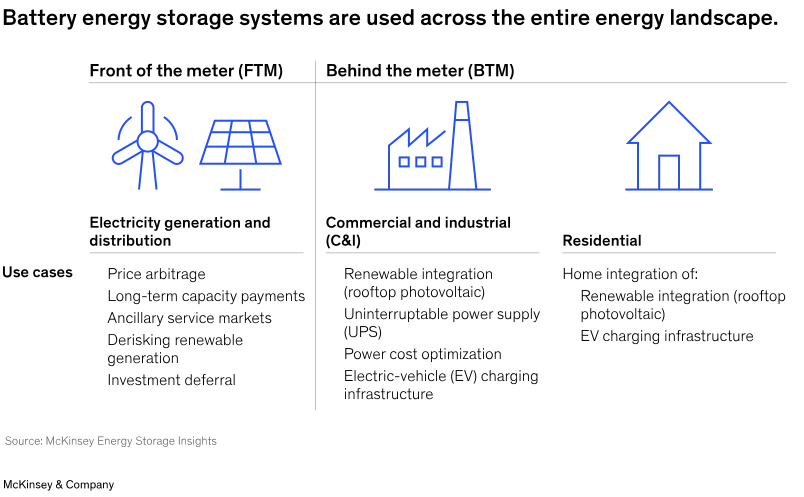As power distribution evolves, it is no longer limited to traditional power plants. Distributed energy sources, such as home solar storage systems and Commercial BESS, provide users with more flexible and stable energy experiences. The terms “in front of the meter” (FTM) and “behind the meter” (BTM) have emerged to distinguish these approaches. This article will explain their definitions, differences, and help you decide which power distribution method suits you best.
What is FTM?
FTM is an acronym for “in front of the meter” and refers to power generation and storage systems located before the meter, which means they are directly connected to the utility grid. FTM systems typically provide power to the entire grid, making them available to all users on that network. For example, the distribution method of power to residences, factories, businesses, etc. through the common utility grid is called FTM.
Common Examples of FTM:
- Large-scale solar farms
- Wind farms
- Utility-scale BESS installations
Typical FTM Customers:
- Utility companies
- Grid operators
- Large industrial or commercial facilities seeking to support grid stability
What is BTM?
BTM is an acronym for “in front of the meter“, refers to power generation and storage systems that are installed after the electric meter, meaning they are directly connected to the consumer’s electrical network. BTM systems primarily serve the needs of individual homes or businesses.
Common Examples of BTM:
- Residential solar panels paired with battery storage
- Commercial energy storage systems for demand response
- Backup power solutions for homes or small businesses
Typical BTM Customers:
- Residential users
- Small and medium-sized businesses
- Industrial facilities seeking to reduce peak demand charges
Advantages and Disadvantages of FTM
Advantages:
Grid-wide impact: Provides energy to the entire grid, enhancing grid stability.
Large-scale capacity: Can support significant power generation and storage needs.
Supports grid operators: Helps balance supply and demand at the utility level.
Disadvantages:
Higher installation costs: Requires large-scale infrastructure and regulatory compliance.
Complexity: Involves more complex grid integration and maintenance.
Advantages and Disadvantages of BTM
Advantages:
Greater user control: Directly benefits the individual user, allowing for self-consumption and energy savings.
Flexibility: Can be scaled from small residential systems to larger commercial installations.
Cost savings: Reduces electricity bills through peak shaving and load shifting.
Disadvantages:
Limited capacity: Typically smaller in scale compared to FTM systems.
Energy management: Requires more hands-on management to maximize benefits.
Front of the Meter vs. Behind the Meter
The primary distinction between Front of the Meter (FTM) and Behind the Meter (BTM) lies in their connection point and purpose.
Key Differences:
Location:
FTM systems are connected directly to the utility grid, serving multiple users and enhancing grid stability.
BTM systems connect after the meter, delivering energy directly to individual users or facilities, focusing on cost savings, backup power, and peak shaving.
Scale & Capacity:
FTM installations are large-scale (MW-GW), such as utility-scale solar farms and centralized BESS, impacting the entire grid.
BTM systems are typically smaller (5kWh-10MWh), tailored for residential, commercial, or industrial applications, and can be more flexible and modular.
Revenue Streams:
FTM projects generate income through wholesale energy markets, grid services, and long-term contracts.
BTM systems offer direct savings by reducing bills, avoiding demand charges, and participating in programs like Virtual Power Plants (VPPs).
Resilience:
FTM solutions provide broad grid support but lack individual backup.
BTM systems ensure user resilience, enabling energy independence during outages.
Which One to Choose?
- Choose FTMif your focus is on supporting grid stability, engaging in large-scale energy projects, or operating at the utility level.
- Choose BTMif you seek energy independence, cost savings, demand-side management, or resilience during grid outages.
FTM and BTM systems offer distinct energy solutions: FTM supports grid stability on a large scale, while BTM provides individual users with cost savings, resilience, and flexibility. The choice between the two depends on whether the focus is on broad grid impact or personal energy management and independence.
What Drives BTM Adoption?
BTM adoption is driven by factors like cost savings, energy independence, demand response, and the need for backup power during outages. Incentives and policies promoting renewable energy also play a crucial role in BTM deployment.
How Can BTM Help Users Generate Revenue?
VPP Participation: Users can integrate BTM systems into VPPs to earn revenue from grid services.
Avoiding Outage Risks: BTM provides reliable backup, reducing downtime and financial losses from outages.
Peak Shaving and Load Shifting: Reducing peak demand lowers utility costs and can generate savings or additional revenue through demand response programs.
How to Build a BTM System
BTM systems are flexible energy solutions, ranging from 5 kWh to 10 MWh. Whether you need a residential backup or a mini-grid solution, there are customized options to meet your requirements. Working with an experienced team like PKNERGY, you can develop a high-return BTM system tailored to your needs. PKNERGY has extensive knowledge and pre-designed solutions, having delivered hundreds of energy storage systems globally. Contact us for a free, no-obligation BTM consultation.
Conclusion
Both FTM and BTM offer unique benefits, with FTM focusing on grid-wide improvements and BTM on user-specific savings and resilience. By understanding their differences, you can make informed decisions about which system best aligns with your energy goals, ensuring a more efficient and cost-effective energy experience.
Save Money, Protect Environment
PKNERGY helps you reduce your energy bills for your home solar energy storage, store your solar energy for use anytime- at night or during an outage.






